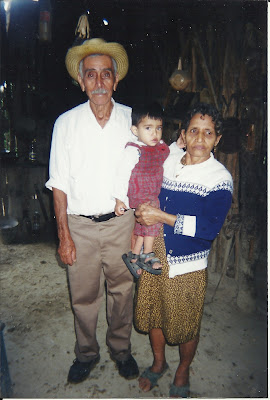The
place with the tongue-twisting name: not all the warmth came from the
sun by any means. The residents exhibited nothing but pleasure in greeting two gringo visitors. Many of them are clearly descendants of the
ancient Totonacan region around us. The native language heavily
influences their Spanish pronunciation. Tecolutla was always a
fishing village, both sea and river. It has two or three main streets intersected by small side streets, very easy to navigate. Of
course it has the expected central plaza, or zocalo as they say.
 |
| Part of the zocalo with the municipal building |
 |
| typical art |
Rosario was excited to have us meet her parents in the mountain village of San Pablo. It's the same mountain range we had followed in southern Tamaulipas state. Her father had an orange "rancho" there, we understood. Her Spanish was so heavily accented that for ages I thought his name was Chili-choro. Hello, Teodoro! Who was actually a labourer for an orange plantation owner. Like any grandparents, they were thrilled with a visit from Torito, not to mention the gringos.
San
Pablo is a (literally) dirt poor village. The huts are vulnerable to
the elements, constructed of cement blocks, boards, and sticks. There
is no water running from a tap, no plumbing or electricity. They only
had about two chairs. Recent rains had washed downhill, turning the
paths into mud. Reaching the outhouse, slipping and sliding past the
prized family pig, was an epic journey.
And
yet these people were warmly hospitable despite the language barrier,
giving us their best meal, tamales cooked on a very large pan over a
kitchen fire. They take corn to a mill on the river to have it ground
for their staple corn meal. Rosario proudly showed us the village
church where we assumed, in our faltering ignorance, she and Hector
had been married. Some time later we established that this is where
little Hector was baptized. We never did resolve the marriage
question.
Meanwhile,
we spent a lot of time on the beach. No beach vendors. No hard sell
anywhere. We were ahead of Easter when the town experiences one of
its booms; other prime times are Christmas, their large (ocean)
fishing derby in May, and summer holidays. The first thing on the
beach that attracted us like a magnet was El Rincon de Don Juan ...
Juan's Place, a restaurant and bar, occasional night club. It was
then we met the irrepressible Juan Carlos, chief booster for all
things Tecolutla.
El
Rincon became a daily destination as we listened to JC's ambitious
plans for the town to become a destination for NorteAmericanos.
We spent hours weighing options and logistics, trading stories. A
sociologist by training, he "came home" to help develop
local interests, environmental concerns being a big part of it.
Sometimes his musicians would show up for lunch or dinner. Sometimes
even the cook would show up.
Otherwise
the little town fast became familiar. And because it was off-season
everyone got to know us, even though some businesses were not
reopened yet for the expected Easter rush. We could put names to
passersby. There were casual restaurants to try, veracruzeano
cooking. It was like eating with a different family each night. Shops
that were open had few local crafts and no souvenirs. But natives of
Guatemala were arriving to sell their crafts on the street.
Telephones
were utterly unreliable. Television was patchy at best. The internet
was still years from having an impact here. The only sign of outside
life was an occasional helicopter flying in to the one grand hotel
(surrounded by a privacy fence). Whereupon Juan would shrug,
"gobierno políticos."
Watching the river fishermen throw their nets; a visit to the tiny
museum; trips to the larger town of Zamora to explore; it was a world
unto itself.
One
day we were entranced by a visit from the voladores, practitioners of
an ancient Totonacan ceremony. They come from nearby Papantla, the
centre of preserving this heritage. It is believed to have originated
as a performance begging the gods for rain. Part of the mystique may
involve the spring equinox which was then approaching. Five men in
elaborate costumes danced along the street to the zocalo. They
climbed a very tall pole and four performed the flying ritual while
the fifth played a flute and small drum. As the men slowly descend
and whirl, they represent the four elements ‒
earth, air, fire, water ‒
and also the four directions. Meanings and symbolism have
changed over time.
Mr.
Gringo always found some local project he could help with―building,
measuring, painting. By the time we left, that first time, Mr. Gringo
had invested in Garabatos to Hector's delight.
©
2016 Brenda Dougall
Merriman



















No comments:
Post a Comment